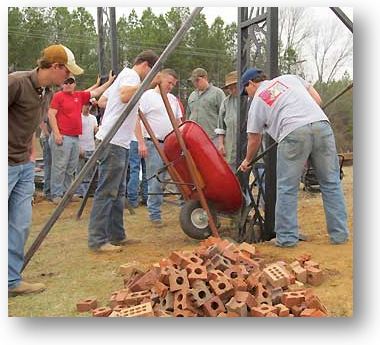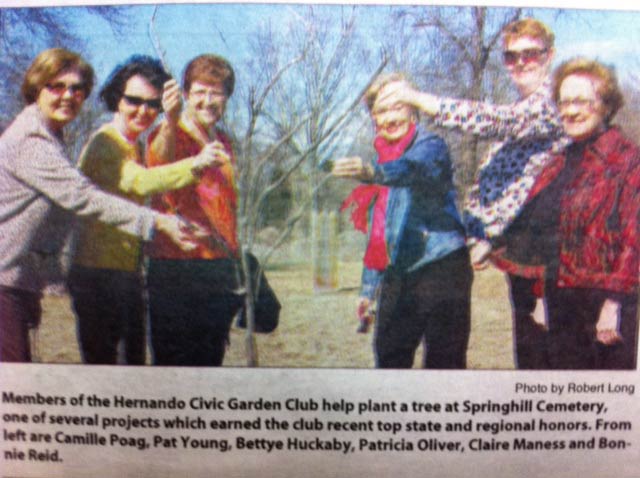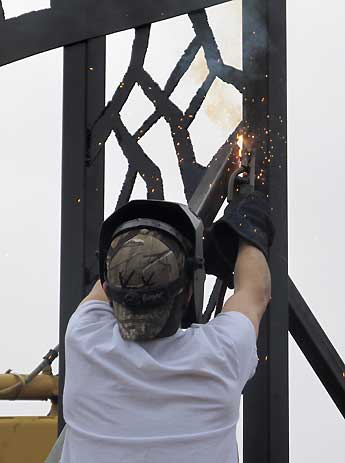SPRINGHILL

| GARDEN NOTES |
|
Garden Planning [attachgardenplan.pdf]
If you would like to contribute plants or time, please visit the JOIN OR DONATE page.
|
| BUILDING A BOTANIC GARDEN |
This page has plans for a botanic collection at Springhill Cemetery. Our emphasis is on returning the site to a native habitat, with an emphasis on plants that provide food and cover for wildlife while respecting the historic landscape. Cedars and hollies are very traditional in old Southern cemeteries, so we will make extensive use of these native evergreens.
A first step in restoring a native landscape is removing non-native plants. Kudzu, privet and honeysuckle were all introduced from China and Japan as ornamentals, but they easily escape from cultivation and threaten native woodlands. Spraying to kill kudzu began in 2010 with funding from the Natural Resources Conservation Service and Forest Service. Control will take 2 or 3 years. Then we hope to plant native species appropriate to loess bluff ravines, like beech, magnolia, tulip poplar and maples. Other grass and shrubbery has to be encouraged until the trees can become well-established.

SPRINGHILL
We also want the botanic collection to be educational, so we have set aside areas for African and Asian plants that were introduced to the Southern US by the 19th century. A row of introduced flowering shrubs would make a colorful and fragrant sidewalk border along Church Street, and show off the plants that had been introduced from India, China and Japan by the mid 19th century, and become essential parts of the Mississippi landscape. Besides many of our garden crops and field crops, there are a number of African ornaments, including evergreens and flowering bulbs. An African garden or courtyard could be the setting for a monument to the unknowns lying in unmarked graves.
Trails should be erosion resistant but soft-surface so as not not to adversely impact the archaeological information below the grass at Springhill. As the landscape is established, small signs will need to be created identifying the different specimens.
| SOIL |

Soils in the Springhill Cemetery are Memphis silt loam, eroded, very gently sloping phase (Ma) and Gullied land, Loring soil material (Gk). The thick loess soil we usually notice today as yellow dust or soupy mud, originally had deep, dark well-drained, brown topsoil and an oak climax hardwood forest. High erodibility is a major hazard on loess soils, so areas of bare ground, particularly on the slopes, should be avoided. Recommended timber planting for Memphis silt loam are loblolly pine on eroded places, or perhaps short-leaf pine; cherrybark, Shumard and white oak on ridge tops; and white or green ash, basswood, black cherry, cucumber tree and southern magnolia, oaks (cherrybark, chinkapin, black, Shumard, southern red, water, and white), persimmon, eastern red cedar, sassafras, sweetgum, black tupelo and yellow poplar on middle and lower slopes. Seedling mortality should be slight, but one of the most important things to remember is that there is a significant hazard of erosion when large equipment is used or the bare soil is exposed to rain, so we should vegetate the steepest slopes with soil-holding plants as soon as possible.
| FEBRUARY 2011 PLANTING |

Cedar
Redbud
Shummard, cherrybark and
Overcup Oak
Ash--wet drainage area
Blueberry and Plum
Mock Orange (Poncirus)--west
hedge
Moss and Fern
Prickly pear and Thread-Leaf
Yucca
Daffodils, Lily of the Valley, Garlic, Monarda, Liatris, Helebore, Iris
and other flowers
| MARCH FLOWERS |
Bridal Wreath (Spirea)
Grape Hyacinth and Daffodils (Old World bulbs)
Henbit and Dandelion (Old World spring herbs)
| KUDZU CONTROL |
The USDA Natural Resources Conservation Service has sprayed the kudzu, but it usually takes two times to kill it. The kudzu was planted for erosion control. As soon as the kudzu is gone, we need to be prepared to keep it from washing again.
The trees for a north facing ravine
are:
Tulip Poplar
Beech
Maple
Magnolia
Sycamore
| A VOLUNTEER, COMMUNITY EFFORT |
In addition, as the cemetery is within a block of the city elementary school, it might be possible to persuade science instructors to use the cemetery as an out-door laboratory to introduce young students to biology thru practical gardening. See the EVENTS page for suggested science learning activities. In time, plantings that need pruning and dividing could be given to students or other volunteers for planting out at home, encouraging them to continue gardening. Obtaining the joint cooperation of garden clubs and schools might prove a community-building measure, and would give the neighborhood a stake in the preservation of the cemetery.


